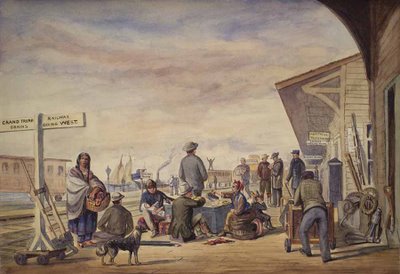From the Archives: Toronto's 1st Union Station - Part 4 of 8
 Click on the picture for a closer look!
Click on the picture for a closer look!The illustration at the right above is a circa 1860 watercolour by William Armstrong that has been reproduced in almost every book about Toronto history and depicts the first Union Station looking southwest. Armstrong used artistic license to incorporate a number of interesting details into his work. Just south of the tracks can be seen the shoreline of Toronto's waterfront, with Grand Trunk passengers cars stored on a siding. The uniformed gentleman with the walking stick standing under the overhang is probably the first stationmaster. The family in the centre of the picture is enjoying a picnic on an overturned crate while awaiting their train. Possibly they are recently arrived immigrants waiting for a connecting train to take them to a smaller agricultural community.
Above them in the distance can be seen a railway brakeman engaged in the dangerous but then standard practice of standing on top of the cars and using hand signals to communicate to the engineer while the train is being assembled. The woman on the left illustrates the propensity for new world artists to include First Nations people in their scenes to provide a touch of the exotic for the European audiences who purchased these prints. In the far distance can be seen the Northern Railway grain elevator that was located at the foot of Portland St. between Bathurst and Brock (now Spadina Ave.) Streets
There were two separate structures comprising the station and both can be seen in the illustration. The far building housed the dining room, telegraph office and ladies waiting room. The nearer building contained the baggage facilities and possibly the men's waiting room as separate facilities for the genders were maintained in railway stations well into the 20th century. The station also included a barbershop, a tradition that has continued in Union Station up to the present time.
Click here to read the next in this series of excerpts from Derek's article on Toronto's 1st Union Station.
By Derek Boles, TRHA Historian






<< Home